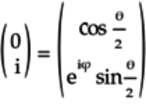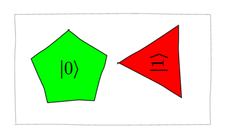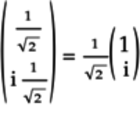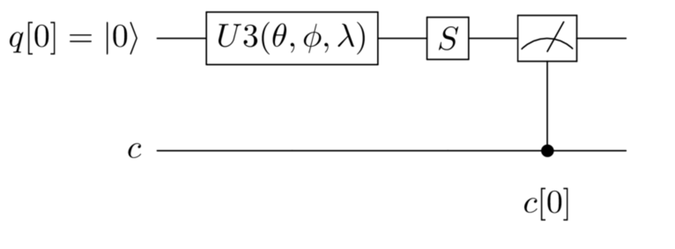Intuitively Analyzing the Quantum Gate Matrix
By this point, you’ve topped up your toolkit with the equation for the quantum state, the Bloch sphere, Universal gates, and quantum gate matrices. Given any quantum gate, you can work out how it’ll modify any arbitrary quantum state. But before reaching into your arsenal, it is always worth trying to see if you can intuitively reason out how the gate acts on the qubit. This will come in handy when you’re designing your own quantum algorithms and want to quickly determine if the gate modifies the qubelets as you want, without getting distracted by the mathematics.
To demonstrate this way of thinking, we’ll work with the S gate defined by the following matrix:

We want to see how this gate affects the following qubit:

Both types of qubelets are rotated from their
non-inverted orientations: the pentagon ![]() qubelet is rotated 90° anticlockwise and the
triangle
qubelet is rotated 90° anticlockwise and the
triangle ![]() qubelet is inverted
upside down 180°. The
relative difference in their orientations,
qubelet is inverted
upside down 180°. The
relative difference in their orientations, ![]() ,
is
,
is ![]() .
We can compute the equation for its
quantum state, but we’ll hold off for a bit.
.
We can compute the equation for its
quantum state, but we’ll hold off for a bit.
Angles Are Measured Anticlockwise | |
|---|---|
|
|
In mathematics, positive angles are measured by going in the anticlockwise direction. Thus, an angle of 270° means rotating three-quarters of a complete rotation anticlockwise. This angle is equivalent to –90°, a quarter-circle rotation in the clockwise direction. |
Before working out how the S gate affects these qubelets, let’s first see how the gate modifies each idealized state.
S Gate on the  Qubit
Qubit
When this gate acts on the ![]() qubit
having a pentagon
qubit
having a pentagon ![]() qubelet,
the first column of the
qubelet,
the first column of the ![]() matrix
defines how it changes the qubit’s state:
matrix
defines how it changes the qubit’s state:

In other words, this gate leaves the pentagon ![]() qubelets alone.
qubelets alone.
S Gate on the  Qubit
Qubit
When a ![]() qubit holding a
triangle
qubit holding a
triangle ![]() qubelet
is fed to this gate, the second column of the
qubelet
is fed to this gate, the second column of the
![]() matrix governs how it changes the qubit’s quantum state:
matrix governs how it changes the qubit’s quantum state:

The modified quantum state only has a triangle
![]() qubelet. But the presence
of the complex number
qubelet. But the presence
of the complex number ![]() hints that
something else is going on with the triangle
hints that
something else is going on with the triangle
![]() qubelet.
qubelet.
Deciphering the Presence of the Complex Number
Recall from Rotating Qubelets Through Any Angle, the vector for a general quantum state and equate it with the vector obtained previously. That is:

The angle ![]() is the relative difference
in orientations between the pentagon
is the relative difference
in orientations between the pentagon ![]() and triangle
and triangle ![]() qubelets, the
quantity that we’re most concerned with.
qubelets, the
quantity that we’re most concerned with.
In keeping with our “down-home” analysis, let’s restate the general quantum state vector as:

Here, the “something” terms indicate values we’re not interested in at the moment. In fact, we can go one step further: since the top term of the vector is 0, we can express the right-hand side of the previous equation as:

Using Euler’s formula,[42] expand ![]() :
:
The expanded form of the vector for the quantum state is:

Since the bottom term of the vector is a
“pure” complex number, namely, ![]() ,
experiment with values that force
,
experiment with values that force
![]() to 0. In fact, it’s
easy to see that if
to 0. In fact, it’s
easy to see that if ![]() or
90°,
or
90°, ![]() .
Moreover,
.
Moreover, ![]() .
.
In other words, the S gate rotates
the triangle ![]() qubelet
by 90° anticlockwise:
qubelet
by 90° anticlockwise:

(Note that since there are no pentagon ![]() qubelets in the idealized
qubelets in the idealized ![]() qubit,
the relative angle
qubit,
the relative angle ![]() is computed from the
position of the triangle
is computed from the
position of the triangle ![]() before the S gate acts on the qubit.)
before the S gate acts on the qubit.)
Now, we can put together the action of the S gate on the original blended qubit:
-
The pentagon
 qubelets
are left alone.
qubelets
are left alone.
-
The triangle
 qubelets
are rotated 90° anticlockwise.
qubelets
are rotated 90° anticlockwise.
Pictorially, the action of the S gate on the blended qubit is shown in the following figure:

Since only the relative difference between the orientations
of the pentagon ![]() and triangle
and triangle
![]() qubelets determine the
angle
qubelets determine the
angle ![]() , you could just as well first rotate
both qubelets by 90° clockwise so that the pentagon
, you could just as well first rotate
both qubelets by 90° clockwise so that the pentagon
![]() qubelet is non-inverted, and
then apply the S gate, as shown in the
following figure:
qubelet is non-inverted, and
then apply the S gate, as shown in the
following figure:

If this action of the S gate meets your needs, then proceed to quantitatively verify the operation and confirm your hunch.
Precisely Calculating the S Gate Action
To apply the S gate matrix to the blended qubit, you need to compute its quantum state vector. Again, we’ll do this quickly:
- Calculating the Qubelet Amplitudes
-
Since the qubit has one pentagon
 and one triangle
and one triangle  qubelet,
the probability of it collapsing to either one of these
is half. Take the square root to get the
amplitudes and write the state as follows:
qubelet,
the probability of it collapsing to either one of these
is half. Take the square root to get the
amplitudes and write the state as follows:

Or, writing as a vector:

Note the
 term on the
bottom element associated with the triangle
term on the
bottom element associated with the triangle
 qubelet. At this point,
we just know the probabilities of choosing a
pentagon
qubelet. At this point,
we just know the probabilities of choosing a
pentagon  or triangle
or triangle
 qubelet from the
blended qubit. We still don’t
know how they’re oriented.
qubelet from the
blended qubit. We still don’t
know how they’re oriented.
- Calculating the Qubelet Orientations
-
Since
 measures the relative
difference in rotations, it helps to
rotate both types of qubelets by 90°
clockwise so that the pentagon
measures the relative
difference in rotations, it helps to
rotate both types of qubelets by 90°
clockwise so that the pentagon  qubelet is non-inverted:
qubelet is non-inverted:

In this quantum state, the relative difference
 between the rotations of the pentagon
between the rotations of the pentagon  and triangle
and triangle  qubelets is still
90° or
qubelets is still
90° or  .
Thus, the term
.
Thus, the term  :
:

And this qubit’s quantum state expressed as a vector is:

Now that we have the quantum state as a vector,
multiply it by the S gate’s matrix
![]() to get the resultant state:
to get the resultant state:

The negative sign in the bottom term comes from
![]() with
with ![]() .
That is,
.
That is,

This vector corresponds to a quantum state
in which the pentagon ![]() qubelet is non-inverted and the triangle
qubelet is non-inverted and the triangle ![]() qubelet is inverted upside down, as shown in the following
figure:
qubelet is inverted upside down, as shown in the following
figure:

This state is identical to the one we informally calculated earlier.
This exercise was, of course, a simple one, and it may have been easier to use the S gate matrix. In general, though, the qubelets could be arbitrarily rotated, and you may need to apply a sequence of gates to get them to the desired state. In these cases, you may often find it easier to work with pictures and identify which rotations of the qubelets you need to apply before validating the operations with precise mathematical calculations.
Before learning to use these matrices when the qubit is acted on by several gates in sequence, it’s helpful to have a handy cheat sheet listing the pertinent details for gates you’ll see in practice.
Try Your Hand
Solutions to these exercises are given in Analyzing Quantum Gate Matrices Solutions.
For any code listing in the exercises, assume the following header lines:
| | OPENQASM 2.0; |
| | include "qelib1.inc"; |
-
In problems and programming exercises so far, you’ve approached them using qubelets. When you’re working as part of a team, however, the other members may not be familiar with this model.[43] So in this exercise, you’ll work through the example in the previous section, but stated using the language and terms you’ll encounter in the workplace.
-
Specify a Universal gate,
 ,
that puts a
,
that puts a  qubit
into a quantum state,
qubit
into a quantum state,  , defined
by the following vector:
, defined
by the following vector:

-
Write a program using this gate and confirm that the quantum state collapses to
 and
and
 as you’d expect.
as you’d expect.
-
Using the parameters for the
 gate you calculated previously, write a program
that implements the following quantum circuit:
gate you calculated previously, write a program
that implements the following quantum circuit:

Use the following statement to declare the S gate:
s q[0]; -
By looking at the output of your program, can you confirm that the pentagon
 qubelets are rotated as you calculated?
qubelets are rotated as you calculated?
-
-
Which gate would you use to rotate the pentagon
 qubelets by
90° clockwise while leaving the
triangle
qubelets by
90° clockwise while leaving the
triangle  qubelets alone,
as shown in the following circuit:
qubelets alone,
as shown in the following circuit:

Intuitively reason out the type of gate you’d use in this circuit.
